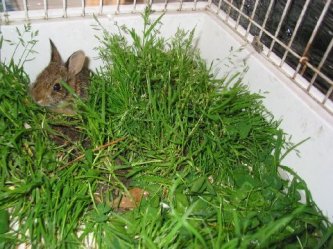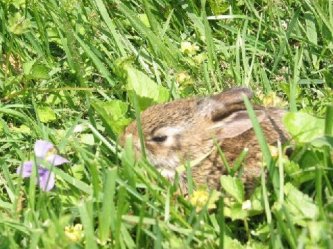The cottontails home is called a form. It is a depression made by the rabbit by digging out or stomping down an oval shape. They do not maintain territories. Home ranges may overlap. The range of an adult male maybe 2 to 3 acres. The female’s territory is approximately 1 acre. The female is called a doe. She will line a form with her chest hair and grass when it is time to have her kits. Cottontails are nocturnal. They rest in their form during the day. Their favorite foraging times are pre-dawn, early morning, pre-dusk and twilight. They are herbivores (plant eaters). They will eat grasses, sedges, leaves, flowers, stems, buds, berries and bark. During the winter months they will eat stems of goldenrod, dogwood, berries and tree bark. Cottontails also practice coprophagy, eating of their feces. Their digestive system requires a continuous flow of nutrition and roughage to remain healthy. Their metabolism is 3 times faster than a cat or dog. They do not require much water due to the vegetation they consume and the dew on the vegetation in the early morning hours.
Rabbits sexually mature at 4 to 6 months. A doe may have 3 to 4 litters per year. The average litter size is 3 to 6. The doe returns to the nest twice a day to feed her kits. She will lay over the form and the kits will rise up to nurse. They lay on their backs and fill their stomachs quickly. Kits are born blind and hairless but in a short 3 weeks they will be weaned and eating on their own. By 4 weeks of age the kits will leave the nest for good. Cottontails are a prey species. They are born knowing what they should do. When startled they will remain motionless for long periods of time or they will flee rapidly. (reprinted with permission from Wild at Heart) |

 The eastern cottontail is the most widely spread species in the United States. They are found everywhere east of the Rocky Mountains. The word “sylvilagus means “wood hare”. Their range extends from Canada to Central America. Cottontails are found in diverse habitats, including woodlands, fields, swamps, farmlands, hedge, prairies and urban yards. In Native American Indian legends, the rabbit is the trickster hero of the southwest tribes. The rabbit, in ancient Indian legends, possessed supernatural powers.
The eastern cottontail is the most widely spread species in the United States. They are found everywhere east of the Rocky Mountains. The word “sylvilagus means “wood hare”. Their range extends from Canada to Central America. Cottontails are found in diverse habitats, including woodlands, fields, swamps, farmlands, hedge, prairies and urban yards. In Native American Indian legends, the rabbit is the trickster hero of the southwest tribes. The rabbit, in ancient Indian legends, possessed supernatural powers. Cottontails are normally very timid, however, they will fiercely defend their kits. Adult cottontails are 14 to 16 inches long and weigh about 3 pounds. They are capable of jumping 8 feet. The average life span is 2 years. Only 25% of cottontails survive their first year. If all of the doe’s brood survived and reproduced, at the end of 5 years, there would be 2.5 billion rabbits. In an area where there is a high number of predators, 85% of the rabbit population will die in one year. Mortality is also affected by weather. The form may be flooded during a storm and the may result in the death of an entire litter.
Cottontails are normally very timid, however, they will fiercely defend their kits. Adult cottontails are 14 to 16 inches long and weigh about 3 pounds. They are capable of jumping 8 feet. The average life span is 2 years. Only 25% of cottontails survive their first year. If all of the doe’s brood survived and reproduced, at the end of 5 years, there would be 2.5 billion rabbits. In an area where there is a high number of predators, 85% of the rabbit population will die in one year. Mortality is also affected by weather. The form may be flooded during a storm and the may result in the death of an entire litter.